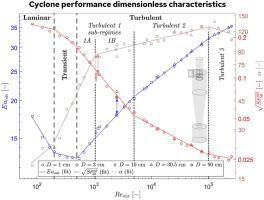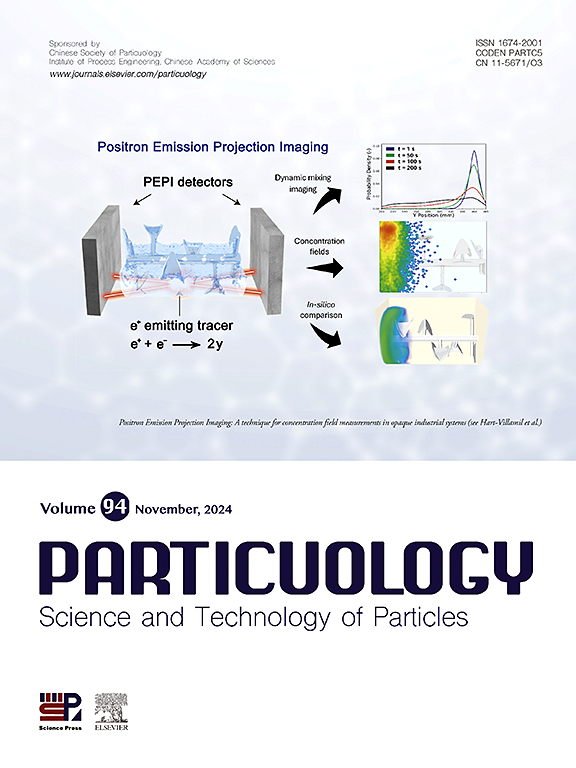Cyclone dimensionless pressure drop, cut size, and separation slope: One dimensionless number (Reynolds) to rule them all
IF 4.1
2区 材料科学
Q2 ENGINEERING, CHEMICAL
引用次数: 0
Abstract
The flow field and performance characteristics of the high-efficiency Stairmand cyclone have been computationally investigated at a wide range of Reynolds numbers Reout = 84 − 252876 by varying the cyclone diameter, inlet velocity, operating temperature and pressure using the LES simulations. The effects of these parameters on the dimensionless cyclone performance characteristics (Euler number, square root of Stokes number and slope of the transformed grade efficiency curve) and dimensionless lip flow and lip velocity have been revealed. Five critical Reynolds numbers which correspond to the transition between different regimes and sub-regimes have been determined. All three dimensionless cyclone performance characteristics and two lip flow characteristics are ruled by the Reynolds number.

旋风分离器的无量纲压降、切割尺寸和分离斜率:一个无量纲数(雷诺数)决定一切
在雷诺数 Reout = 84 - 252876 的宽范围内,通过改变旋风分离器直径、入口速度、工作温度和压力,利用 LES 仿真对高效 Stairmand 旋风分离器的流场和性能特征进行了计算研究。这些参数对无量纲旋风分离器性能特征(欧拉数、斯托克斯数平方根和转化级效率曲线斜率)以及无量纲唇流和唇速的影响已经揭示。确定了五个临界雷诺数,它们对应于不同制度和子制度之间的过渡。所有三个无量纲旋流器性能特征和两个唇流特征都受雷诺数的影响。
本文章由计算机程序翻译,如有差异,请以英文原文为准。
求助全文
约1分钟内获得全文
求助全文
来源期刊

Particuology
工程技术-材料科学:综合
CiteScore
6.70
自引率
2.90%
发文量
1730
审稿时长
32 days
期刊介绍:
The word ‘particuology’ was coined to parallel the discipline for the science and technology of particles.
Particuology is an interdisciplinary journal that publishes frontier research articles and critical reviews on the discovery, formulation and engineering of particulate materials, processes and systems. It especially welcomes contributions utilising advanced theoretical, modelling and measurement methods to enable the discovery and creation of new particulate materials, and the manufacturing of functional particulate-based products, such as sensors.
Papers are handled by Thematic Editors who oversee contributions from specific subject fields. These fields are classified into: Particle Synthesis and Modification; Particle Characterization and Measurement; Granular Systems and Bulk Solids Technology; Fluidization and Particle-Fluid Systems; Aerosols; and Applications of Particle Technology.
Key topics concerning the creation and processing of particulates include:
-Modelling and simulation of particle formation, collective behaviour of particles and systems for particle production over a broad spectrum of length scales
-Mining of experimental data for particle synthesis and surface properties to facilitate the creation of new materials and processes
-Particle design and preparation including controlled response and sensing functionalities in formation, delivery systems and biological systems, etc.
-Experimental and computational methods for visualization and analysis of particulate system.
These topics are broadly relevant to the production of materials, pharmaceuticals and food, and to the conversion of energy resources to fuels and protection of the environment.
 求助内容:
求助内容: 应助结果提醒方式:
应助结果提醒方式:


